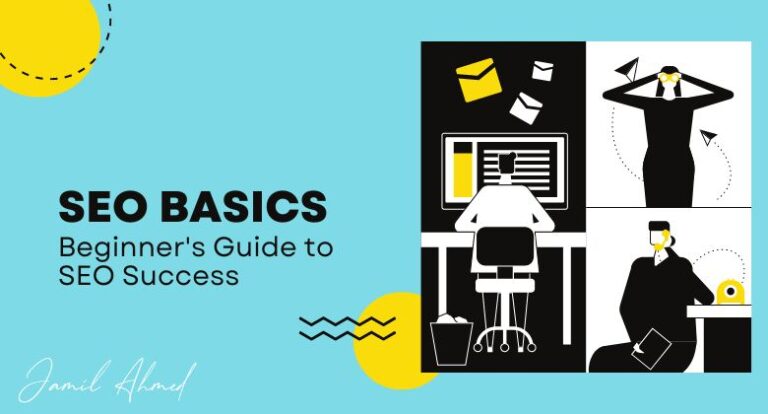SEO Basics – Beginner’s Guide to SEO Success


My step-by-step guide covers everything from defining your brand to creating a website, SEO and using social media to your advantage. Start building a strong personal brand today!
SEO Basics: Essential strategies to boost your website’s visibility, optimize content, and drive organic traffic with these SEO tips.
Search Engine Optimization (SEO) is a fundamental concept for anyone looking to improve their website’s visibility online. Whether you’re new to digital marketing or a seasoned professional, understanding the basics of SEO is essential. I’ll break down the SEO basics so that you can start building a strategy that drives traffic, increases visibility, and boosts your online presence.
What is SEO?
SEO, or Search Engine Optimization, is the practice of optimizing your website to rank higher on search engine results pages (SERPs), such as Google, Bing, and Yahoo.
The goal of SEO is to make your website more attractive to search engines like Google and other search engines, which in turn makes it more accessible to users searching for information related to your content, products, or services.
When you type a query into Google, the search engine’s algorithms analyze all the web pages it has indexed to present the most relevant results. SEO involves various techniques, from keyword research and on-page optimization to link building and technical SEO, all aimed at improving your site’s ranking for specific target keywords. By mastering the basics of SEO, you can ensure your website appears prominently when people search for terms related to your business.
Why is SEO Important?
Understanding basic SEO is important because it directly impacts your website’s visibility and, consequently, your business’s success.
Here’s why SEO optimization basics are so vital:
- Increased Visibility: SEO significantly boosts a website’s visibility on search engine results pages (SERPs). Studies show that over 43% of searchers click on organic results. In contrast, only about 2% click on paid ads. This indicates that users tend to trust organic results more, making it essential for businesses to optimize their sites to appear on the first page of SERPs.
- Organic Traffic: SEO is a cost-effective method for attracting organic traffic. Unlike paid advertising, which incurs costs per click, organic traffic is free and sustainable. For instance, businesses that invest in SEO see an average of 14.6% conversion rate from organic traffic, compared to just 1.7% from traditional outbound methods. This highlights the long-term benefits of SEO in generating qualified leads.
- Credibility and Trust: Websites that rank highly are often perceived as more credible. According to research, 75% of users never scroll past the first page of search results, which means that high-ranking sites are more likely to be trusted by users. This trust translates into improved brand reputation and customer loyalty.
- Better User Experience: SEO practices contribute to a better user experience, which is increasingly important for search rankings. For example, Google considers page load speed as a ranking factor. A study found that 53% of mobile users abandon sites that take longer than three seconds to load. Therefore, optimizing for speed and mobile-friendliness not only enhances user satisfaction but also improves SEO performance.
- Competitive Advantage: Implementing SEO can provide a significant edge on your business. Research indicates that companies that prioritize SEO are 13 times more likely to achieve a positive ROI. By optimizing their websites, businesses can outperform competitors who neglect this crucial aspect of digital marketing.
- Long-Term Strategy: SEO is a long-term investment. Unlike short-term marketing tactics, the effects of SEO can accumulate over time. For instance, websites that regularly update their content can see a traffic increase of up to 30% within six months. This sustained growth makes SEO a vital component of any marketing strategy.In summary, SEO is essential for increasing visibility, attracting organic traffic, building credibility, enhancing user experience, gaining a competitive advantage, and ensuring long-term success. Implementing effective SEO strategies can lead to substantial business growth and improved online presence.
The basics of SEO are essential for anyone looking to build a successful online presence.
By understanding what SEO is and how it works, you can create a foundation for effective SEO strategies that will help your website rank higher, attract more visitors, and ultimately, achieve your business goals.
SEO Basics – Beginner’s Guide to SEO Success
Getting Started with SEO
It’s important to understand how search engines work and the key components that make up an effective SEO strategy. Knowing these basics will help you build a strong foundation for your SEO optimization efforts.
Understanding Search Engines
Search engines like Google, Bing, and Yahoo are the primary tools people use to find information online. When you enter a query into a search engine, it scans its vast index of web pages to deliver the most relevant results based on several ranking factors. But how does this process work?
- Crawling: Search engines use bots, known as “crawlers” or “spiders,” to discover and collect data from billions of web pages. These crawlers navigate from one link to another, indexing the content they find along the way.
- Indexing: After crawling, the search engine processes and stores the information in a massive database known as the index. This index is a vast repository of all the web pages that the search engine has found and deemed relevant for future searches.
- Ranking: When a user searches for something, the search engine uses complex algorithms to sort through the indexed pages and rank them based on relevance, quality, and many other factors. The goal is to present the most helpful and accurate information at the top of the search engine results pages (SERPs).
Understanding how search engines work is the first step in mastering the basics of SEO. By knowing what search engines prioritize, you can tailor your SEO strategies to meet these criteria and improve your website’s visibility.
Key Components of SEO
SEO is a multifaceted discipline that involves optimizing various aspects of your website to improve its performance in search results.
The key components of SEO can be broken down into three main categories:
- On-Page SEO,
- Off-Page SEO, and
- Technical SEO.
On-Page SEO
The On-Page SEO refers to the optimization of individual web pages to rank higher and earn more relevant traffic. This includes:
- Keyword Research: Identifying the right target keywords that people search for and incorporating them naturally into your content.
- Meta Descriptions and Title Tags: Crafting compelling and keyword-rich meta descriptions and title tags that encourage users to click through to your site.
- Header Tags (H1, H2, H3, etc.): Using header tags to structure your content, making it easier for search engines to understand and index your page.
- Content Creation: Writing high-quality, relevant content that provides value to users and encourages engagement.
- Internal Linking: Linking to other relevant pages within your website to help search engines understand the structure of your site and keep users engaged.
Off-Page SEO
- The Off-Page SEO involves activities that happen outside of your website but impact your rankings. This includes:
- Link Building: Acquiring high-quality backlinks from other reputable websites, which signals to search engines that your site is authoritative and trustworthy.
- Social Media: Leveraging social media platforms to promote your content and increase its visibility.
- Brand Mentions: Getting your brand mentioned on other websites, even without a direct link, can also positively impact your SEO.
Technical SEO
Technical SEO focuses on the backend aspects of your website that affect how search engines crawl and index your site. This includes:
- Page Speed: Ensuring your website loads quickly, as page speed is a significant ranking factor for search engines.
- Mobile Optimization: Making sure your website is fully optimized for mobile devices, as more users are accessing the web via smartphones.
- XML Sitemap and Robots.txt: Using an XML sitemap to help search engines navigate your site, and a robots.txt file to control which pages are crawled.
- SSL Certificate: Implementing HTTPS to secure your website, which is important for both SEO and user trust.
Each of these components plays a critical role in a successful SEO strategy. By implementing these SEO strategies in you SEO plan, you can create a well-rounded approach that improves your site’s visibility, attracts more traffic, and ultimately leads to better results on engine results pages (SERPs).
Keyword Research
Keyword research is the cornerstone of any successful SEO strategy. Understanding the importance of keywords in SEO and knowing how to find the right ones can dramatically improve your site’s visibility in search engine results pages (SERPs).
Importance of Keywords in SEO
Keywords are the phrases and terms that users type into search engines when looking for information. These keywords act as a bridge between what people are searching for and the content you provide. Here’s why they are crucial for SEO optimization:
- Relevance: Keywords help search engines understand the content of your pages, ensuring they match relevant search queries. When you use the right target keywords, your content is more likely to appear in front of users who are searching for topics related to your business.
- Traffic Generation: By targeting high-volume, relevant keywords, you can drive more organic traffic to your site. Proper keyword usage can lead to higher rankings, making it easier for potential customers to find you.
- User Intent: Keywords reflect what users are searching for and their intent. Whether they are looking for information, products, or services, understanding the intent behind keywords allows you to create content that meets their needs, improving both user satisfaction and SEO performance.
- Competitive Advantage: Conducting thorough keyword research allows you to discover opportunities your competitors might be missing. By targeting less competitive but highly relevant keywords, you can gain an edge in the market.
How to Find the Right Keywords
Finding the right keywords involves understanding your audience and analyzing search trends. Here’s how to do it:
- Brainstorming: Start by listing words and phrases related to your business, products, or services. Think about what potential customers might search for and how they might phrase their queries.
- Analyze Competitors: Look at the keywords your competitors are ranking for. Tools like Ahrefs and SEMrush allow you to see which keywords are driving traffic to their sites, giving you insights into your industry’s keyword landscape.
- Long-Tail Keywords: Focus on long-tail keywords, which are more specific and usually less competitive. These keywords might have lower search volumes, but they often lead to higher conversion rates because they capture users with a clear intent.
- User Intent: Consider the intent behind each keyword. Are users looking to buy something (transactional intent), gather information (informational intent), or navigate to a specific site (navigational intent)? Align your keywords with the appropriate type of content.
Tools for Keyword Research
Several tools can help you conduct effective keyword research. Here are some of the most popular:
- Google Keyword Planner: A free tool from Google that provides insights into keyword search volumes, competition levels, and suggests related keywords. It’s a great starting point for discovering new keywords.
- Ahrefs: A comprehensive SEO tool that offers detailed keyword analysis, including search volume, keyword difficulty, and competitor keyword research. Ahrefs is powerful for identifying both broad and niche keywords.
- SEMrush: Similar to Ahrefs, SEMrush provides in-depth keyword research features. It also offers keyword suggestions, tracks your keyword rankings, and analyzes your competitors’ keywords. Try SEMrush! Free 7-Days Trial.
- Ubersuggest: A user-friendly tool that generates keyword ideas based on a seed keyword. It provides useful data on search volume, keyword difficulty, and related keywords.
- Moz Keyword Explorer: Moz offers a keyword research tool that provides keyword suggestions, difficulty scores, and potential click-through rates, helping you prioritize which keywords to target.
On-Page SEO Optimization
On-page SEO involves optimizing individual pages on your website to rank higher and earn more relevant traffic. It includes various elements that need to be optimized, from content creation to meta tags and images.
Creating High-Quality Content
Content is king in SEO. High-quality content not only attracts users but also encourages other websites to link to you, boosting your authority and rankings. Here’s how to create content that performs well:
- User-Focused: Write content that addresses your audience’s needs and answers their questions. Understand what your users are searching for and provide comprehensive, valuable information.
- Keyword Integration: Naturally integrate your target keywords throughout your content. Avoid keyword stuffing, as this can harm your rankings. Instead, use keywords in key areas like the introduction, headers, and conclusion.
- Engaging and Readable: Make your content easy to read with short paragraphs, bullet points, and clear headings. Engaging content keeps users on your page longer, which is a positive signal to search engines.
- Regular Updates: Keep your content fresh by regularly updating it. Search engines favor websites that provide up-to-date information, which can help improve your rankings over time.
Optimizing Meta Tags (Title, Meta Description)
Meta tags play a significant role in how search engines and users perceive your pages. Here’s how to optimize them:
- Title Tags: Your title tag should be concise, descriptive, and include your primary keyword. It’s one of the most important on-page SEO factors, as it directly impacts your click-through rate.
- Meta Descriptions: Write a compelling meta description that summarizes the content of the page and includes relevant keywords. While meta descriptions don’t directly affect rankings, they can influence users’ decision to click on your link.
- Character Limits: Keep title tags under 60 characters and meta descriptions under 160 characters to ensure they display correctly in SERPs.
Using Header Tags Properly
Header tags (H1, H2, H3, etc.) are used to structure your content and make it easier for both users and search engines to understand. Here’s how to use them:
- H1 Tag: Your H1 tag should include your primary keyword and clearly define the topic of your page. Each page should have only one H1 tag.
- H2 and H3 Tags: Use H2 tags for main sections and H3 tags for subsections. This hierarchical structure helps search engines understand the content and improves readability.
- Keyword Usage: Include keywords naturally in your header tags, but focus more on making them descriptive and helpful for users.
Image Optimization (Alt Text, Compression)
Images enhance user experience, but they can also impact your SEO. Properly optimized images can improve page load speed and provide additional opportunities for keyword usage.
- Alt Text: Alt text describes the content of an image for both users and search engines. Use descriptive alt text that includes relevant keywords to improve your page’s accessibility and SEO.
- Image Compression: Large images can slow down your website, negatively impacting your page speed, a key ranking factor. Compress images to reduce their file size without sacrificing quality.
- File Names: Rename image files with descriptive, keyword-rich names before uploading them to your site. This helps search engines understand the content of the image.
Technical SEO
Technical SEO ensures that your website meets the technical requirements of search engines, helping them crawl, index, and rank your site more effectively.
Improving Website Speed
Page speed is crucial for both user experience and SEO. A slow website can lead to higher bounce rates and lower rankings. Here’s how to improve it:
- Optimize Images: As mentioned earlier, compressing images can significantly improve load times.
- Minify CSS, JavaScript, and HTML: Reducing the size of these files can help your pages load faster.
- Use Browser Caching: Caching stores parts of your website in a user’s browser, reducing the load time for future visits.
- Leverage Content Delivery Networks (CDNs): CDNs distribute your content across multiple servers worldwide, ensuring users receive data from the nearest server, speeding up load times.
Mobile Friendliness
With more users accessing websites via mobile devices, having a mobile-friendly site is critical. Google’s mobile-first indexing means that the mobile version of your site is prioritized in search results.
- Responsive Design: Ensure your website is responsive, meaning it adjusts to fit any screen size, from desktop to mobile.
- Mobile Speed: Optimize your site’s mobile speed using tools like Google’s Mobile-Friendly Test and PageSpeed Insights.
- Avoid Flash: Flash is not supported on most mobile devices and can slow down your site. Instead, use HTML5 for multimedia content.
XML Sitemap and Robots.txt
An XML sitemap and robots.txt file help search engines understand and navigate your site more effectively.
- XML Sitemap: An XML sitemap lists all the important pages on your website, ensuring search engines can find and crawl them. Submit your sitemap to Google Search Console to help with indexing.
- Robots.txt: This file tells search engines which pages they can and cannot crawl. Use it to prevent search engines from indexing low-priority pages like admin areas or duplicate content.
SSL Certificate
Security is a top priority for both users and search engines. An SSL certificate encrypts data between your website and its visitors, making your site more secure.
- HTTPS: Ensure your site is secured with HTTPS rather than HTTP. Google gives a ranking boost to secure sites, and it’s essential for user trust.
- SSL Installation: Most web hosts offer free SSL certificates. Once installed, make sure to update all internal links to point to the HTTPS version of your site.
Off-Page SEO
Off-page SEO refers to actions taken outside of your website that affect your rankings. The most important aspect of off-page SEO is building a strong backlink profile.
Importance of Backlinks
Backlinks are links from other websites to your own. They act as votes of confidence, signaling to search engines that your content is valuable and trustworthy.
- Authority: Links from high-authority sites (like news outlets, educational institutions, or industry leaders) carry more weight and can significantly boost your rankings.
- Relevance: Backlinks from websites related to your industry or niche are more valuable than links from unrelated sites. They tell search engines that your content is relevant to the topic.
- Diversity: A diverse backlink profile, with links from various sources, appears more natural and is more beneficial for SEO.
Building a Strong Backlink Profile
Here are some strategies to build a strong backlink profile:
- Content Creation: Create high-quality, shareable content that others want to link to. This could include blog posts, infographics, or research reports.
- Guest Blogging: Write guest posts for reputable sites in your industry. In return, you’ll often receive a backlink to your site.
- Outreach: Reach out to bloggers, journalists, and influencers in your industry, sharing your content and asking for a link if they find it valuable.
- Broken Link Building: Find broken links on other websites and suggest your content as a replacement. This helps the site owner while earning you a backlink.
Social Media and SEO
While social media links don’t directly impact SEO, they can amplify your content’s reach, leading to more backlinks and traffic.
- Content Promotion: Share your content across social media platforms to increase its visibility and potential for shares and links.
- Engagement: Engage with your audience on social media by responding to comments and participating in discussions. Higher engagement can lead to more shares and visibility.
- Brand Awareness: A strong social media presence builds brand awareness, which can indirectly contribute to SEO by increasing branded searches and direct traffic.
Monitoring and Analytics
To ensure your SEO strategies are effective, it’s essential to monitor and analyze your website’s performance. Tracking key metrics allows you to understand what’s working, identify areas for improvement, and make data-driven decisions that enhance your SEO optimization. Let’s explore how to set up the right tools and avoid common mistakes in your SEO basics journey.
Setting Up Google Analytics
Google Analytics is a powerful tool that provides insights into how visitors interact with your website. Setting it up is one of the first steps in monitoring your SEO performance.
- Create a Google Analytics Account: If you don’t already have a Google Analytics account, sign up for free at analytics.google.com. Follow the prompts to create a new account and add your website.
- Add Tracking Code: Once your account is set up, you’ll receive a unique tracking code. This code needs to be added to every page of your website. If you’re using a platform like WordPress, there are plugins like “Google Site Kit” or “MonsterInsights” that make this process easier.
- Set Up Goals: Define what you want to track on your site, such as form submissions, product purchases, or newsletter sign-ups. Setting up goals in Google Analytics helps you measure the success of your SEO strategies.
- Analyze Reports: Google Analytics provides various reports that show you traffic sources, user behavior, and conversions. Pay attention to metrics like bounce rate, average session duration, and pages per session to understand how users are engaging with your content.
- Track Organic Traffic: To specifically monitor the impact of your SEO basics, focus on organic traffic. Go to Acquisition > All Traffic > Channels in Google Analytics, and filter by “Organic Search” to see how your SEO efforts are driving traffic.
Using Google Search Console
Google Search Console is another essential tool for monitoring your site’s presence in Google search results. It provides valuable insights into how Google views your site and helps you identify and fix issues that could affect your rankings.
- Set Up Google Search Console: To get started, go to search.google.com/search-console and sign in with your Google account. Add your website and verify ownership using one of the methods provided (HTML file upload, DNS record, Google Analytics tracking code, etc.).
- Submit Your Sitemap: After verification, submit your XML sitemap (which you should have already created in the technical SEO phase) to Google Search Console. This helps Google crawl and index your website more effectively.
- Monitor Performance: The Performance report shows you how your site is doing in Google search. Key metrics include total clicks, total impressions, average CTR (click-through rate), and average position. Use this data to track the effectiveness of your SEO strategies and identify which keywords are driving traffic.
- Check Coverage and Indexing Issues: The Coverage report shows you which pages of your site have been indexed by Google and highlights any errors that might prevent pages from being indexed. Regularly check for issues and resolve them promptly.
- Optimize for Mobile: Use the Mobile Usability report to ensure your site is mobile-friendly. With Google’s mobile-first indexing, mobile optimization is a critical component of your basic SEO.
- Track Backlinks: Google Search Console also provides insights into your backlink profile. Review which sites are linking to yours and ensure that these links are from reputable sources to avoid poor quality backlinks.
Tracking SEO Performance
Consistently tracking your SEO performance is key to long-term success. Here are some tips on how to effectively monitor your progress:
- Set Key Performance Indicators (KPIs): Identify the key metrics that matter most to your business, such as organic traffic, keyword rankings, conversion rates, and bounce rates. Regularly monitor these KPIs to gauge your SEO basics effectiveness.
- Use Rank Tracking Tools: Tools like Ahrefs, SEMrush, and Moz can help you track your keyword rankings over time. Regularly check how your target keywords are performing in the search engine results pages (SERPs) and adjust your strategy as needed.
- Analyze User Behavior: Use Google Analytics to analyze how users are interacting with your site. Look for trends in user behavior, such as which pages have the highest engagement or which pages are causing users to leave.
- Monitor Competitors: Keep an eye on your competitors’ SEO performance. Tools like SEMrush can help you track your competitors’ keyword rankings and backlink profiles, giving you insights into where you can improve.
- Review and Adjust: SEO is not a one-time task; it requires ongoing effort. Regularly review your performance data, identify what’s working, and make adjustments to your SEO strategies to keep improving.
Common SEO Mistakes to Avoid
Even with the best intentions, it’s easy to make mistakes that can hurt your SEO efforts. Here are some common SEO mistakes and how to avoid them:
Keyword Stuffing
Keyword stuffing is the practice of overloading your content with keywords in an attempt to manipulate search engine rankings. This outdated tactic can actually harm your rankings.
- Avoid Overuse: Instead of repeating keywords excessively, focus on creating natural, readable content. Use synonyms and related terms to vary your language without sacrificing relevance.
- Prioritize Quality: Search engines prioritize high-quality content that provides value to users. Write for your audience first, and ensure your content flows naturally.
Ignoring Mobile Users
With the rise of mobile browsing, ignoring mobile users can significantly impact your SEO performance.
- Ensure Mobile Friendliness: Use responsive design to ensure your site looks and functions well on all devices. Test your site using Google’s Mobile-Friendly Test tool.
- Optimize for Speed: Mobile users expect fast load times. Compress images, minify code, and leverage browser caching to improve page speed on mobile devices.
Poor Quality Backlinks
Backlinks are important, but not all links are created equal. Poor quality backlinks from spammy or irrelevant sites can hurt your SEO.
- Focus on Quality: Build backlinks from reputable, high-authority sites within your industry. Avoid link schemes and buying links, as these can lead to penalties from Google.
- Monitor Your Backlink Profile: Regularly review your backlinks using tools like Ahrefs or Google Search Console. Disavow any links from low-quality or spammy sites to protect your site’s integrity.
Wrapping Up: SEO Basics
Key Points:
Understanding and implementing the basics of SEO is crucial for anyone looking to improve their website’s visibility and performance. Here’s a quick recap of the key points covered:
- Keyword Research: Identify and target the right keywords to attract relevant traffic.
- On-Page SEO Optimization: Focus on creating high-quality content, optimizing meta tags, using proper header tags, and optimizing images.
- Technical SEO: Improve your website’s speed, ensure mobile-friendliness, and implement essential tools like XML sitemaps and SSL certificates.
- Off-Page SEO: Build a strong backlink profile and leverage social media to enhance your SEO efforts.
- Monitoring and Analytics: Use tools like Google Analytics and Google Search Console to track your SEO performance and make data-driven decisions.
- Avoid Common SEO Mistakes: Steer clear of keyword stuffing, ignoring mobile users, and accumulating poor-quality backlinks.
Start by implementing these SEO basics for beginners, and gradually refine your strategy as you learn what works best for your site.
Remember, SEO is a long-term investment, and the efforts you put in today will pay off with improved rankings, more traffic, and greater success over time.
Now that you have the knowledge, it’s time to take action. Begin optimizing your website today and set yourself up for SEO success!
You May Also Like:





